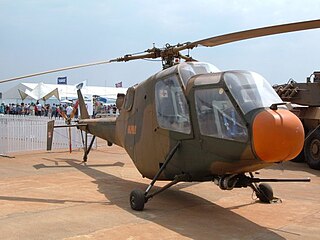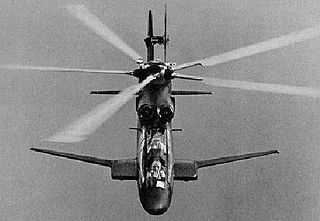
The Atlas XH-1 Alpha is a prototype attack helicopter built by Atlas Aviation of South Africa, which used it as a concept demonstrator for the then-planned Rooivalk project.

The Sikorsky S-67 Blackhawk was a private-venture, prototype attack helicopter built in 1970 with Sikorsky Aircraft research and development (R&D) funds. A tandem, two-seat aircraft designed around the dynamic drive and rotor systems of the Sikorsky S-61, it was designed to serve as an attack helicopter or to transport up to eight troops into combat.
The Aerospace General Mini-Copter was a miniature helicopter designed to be air-dropped to U.S. military pilots stranded behind enemy lines or in otherwise inaccessible areas.

The Westland Westminster was a British helicopter of the 1950s from Westland Aircraft. A large cargo design, it was powered by two turboshaft engines driving a single, five-bladed rotor. Initially unclad, the all-metal airframe was later enclosed in a fabric covering. Designed and built as a private venture without government assistance, it was cancelled when Westland took over rival helicopter producers and their more advanced projects.

The BŻ-4 Żuk, formerly known as GIL-4, was a Polish four-seat light helicopter built in the 1950s. Although it pioneered a novel rotor and transmission system, it never entered series production.

The Bölkow Bo 103 was a small experimental helicopter flown in West Germany in 1961 to research new rotor systems. While the mechanics of the aircraft were based on the Bo 102 captive training rig, the Bo 103 was capable of fully independent flight. In configuration, it was absolutely minimalist - consisting of nothing more than a tubular frame to which the dynamic components and the pilots seat were attached, although a small fibreglass cabin was eventually attached. The aircraft retained the Bo 102's single-rotor of Glass-reinforced plastic, and proved that this was suitable for true flight. The prototype is preserved at the Hubschraubermuseum Bückeburg.
The SNCASE SE.3120 Alouette ("Lark") was a utility helicopter developed in France in the early 1950s but which did not enter production. Designed in parallel with the SE.3110, the Alouette shared that machine's dynamic components, with the exception of its unusual twin tail rotor. The Alouette featured an open-framework fuselage behind a cockpit that was enclosed by a bubble canopy. Skid undercarriage and tricycle gear were both tested.

The Sikorsky XH-39, developed by Sikorsky Aircraft in 1954, was the U.S. Army's first turbine-powered helicopter. It was fast and innovative, but ultimately rejected by the United States Army in favor of the Bell UH-1 Iroquois.
The Kamov Ka-115 Moskvichka is a light multi-purpose helicopter designed for many uses, including passenger and cargo transportation, emergency service, SAR and patrol, or charter flights.

The Agusta A.105 was an Italian rotorcraft designed by Agusta. It was never developed beyond the prototype stage.

The Doblhoff/WNF 342 was the first helicopter to take off and land using tip jets to drive the rotor.

The Dornier Do 32E was a simple, collapsible one-man helicopter, designed for military use in Germany in the 1960s. Despite initial hopes of large orders and some proposed civilian roles, only three flew.

The Focke-Achgelis Fa 225 was an experimental single-seat rotary wing glider built in Nazi Germany by Focke-Achgelis in 1942. Only a single example was constructed.
The Airmaster H2-B1 is a British two-seat ultralight helicopter built by Airmaster Helicopters of Camberley, Surrey.

The PZL SM-4 Łątka was a prototype three-seat helicopter of the 1960s, developed by WSK PZL-Świdnik in Poland. Of largely conventional design and construction, a single prototype was built, but was not flown as a result of engine problems.
The SNCASE SE-3110 or Sud-Est SE-3110 was a French two seat experimental helicopter with unusual twin, angled tail rotors, first flown in 1950. After brief tests SNCASE decided to concentrate on a closely related but single-tail-rotor design.
The Arrow Coax Livella Uno is a German helicopter under development by Arrow Coax Ultra Light Helicopter of Hornhausen and introduced at the AERO Friedrichshafen airshow in 2015. The aircraft is intended to be supplied as a kit for amateur construction.
The Auroa Helicopters Auroa is a New Zealand helicopter designed and produced by Auroa Helicopters Limited of Manaia, Taranaki, introduced in 2013. The aircraft is supplied complete and ready-to-fly.

The Youngcopter Neo (transl. New) is a German NOTAR helicopter that was designed by Björn Jung and is under development by his company, Youngcopter of Mainz. It was first publicly introduced at the ILA Berlin Air Show in 2008. The aircraft is intended to be supplied as a kit for amateur construction.
The McDonnell 120 Flying Crane, also V-1 Jeep, was a lightweight utility flying crane helicopter designed and built by the McDonnell Aircraft Corporation during the 1950s. The open frame fuselage supported the three gas-producers and main rotor mast, with a small single-seat cockpit in the nose, which was originally open, but later enclosed.












